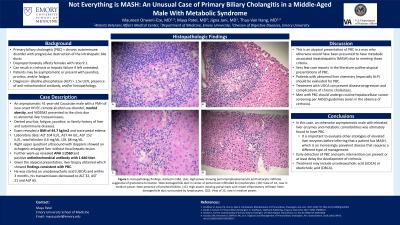Sunday Poster Session
Category: Liver
P1100 - Not Everything Is NASH: An Unusual Case of PBC in a Middle-Aged Male With Metabolic Syndrome
Sunday, October 22, 2023
3:30 PM - 7:00 PM PT
Location: Exhibit Hall

Has Audio

Maya Patel, MS, MD
Emory University School of Medicine
Atlanta, GA
Presenting Author(s)
Maureen Onweni-Eze, MD1, Maya Patel, MS, MD2, Thuy-Van Hang, MD3
1Atlanta VA Medical Center, Emory University School of Medicine, Decatur, GA; 2Emory University School of Medicine, Atlanta, GA; 3Atlanta VA Medical Center, Emory University School of Medicine, Atlanta, GA
Introduction: Primary biliary cholangitis (PBC) is a chronic autoimmune disorder characterized by progressive destruction of the intrahepatic bile ducts, which typically affects females and can result in cirrhosis and hepatic failure if untreated. We present a unique case of an asymptomatic middle-aged male with a clinical picture that is most consistent with non-alcoholic steatohepatitis (NASH), who was subsequently diagnosed with PBC.
Case Description/Methods: A 41-year-old Caucasian male with a history of new onset systolic congestive heart failure, remote alcohol use disorder, morbid obesity, and non-insulin dependent diabetes mellitus type II presented to the clinic due to abnormal liver transaminases. He was asymptomatic and denied pruritus, fatigue, jaundice, and family history of liver and autoimmune diseases. Physical exam revealed a BMI of 47.7 kg/m2 and trace pedal edema. Labs were significant for ALT 104 IU/L, AST 44 IU/L, ALP 152 IU/L, total bilirubin 0.6 mg/dL, LDL 68 mg/dL. Right upper quadrant ultrasound with dopplers showed an echogenic enlarged liver without focal hepatic lesion. Further work-up revealed ANA 1:2560 and positive antimitochondrial antibody with 1:640 titer. Given the atypical presentation, liver biopsy was obtained, which revealed chronic active hepatitis, lymphoplasmacytic triaditis and focal portal, periportal and lobular granulomas, grade 2 portal/periportal activity, grade 1 lobular activity, stage 1 fibrosis, and minimal steatosis, confirming PBC. He was started on ursodeoxycholic acid and within 3 months, his transaminases decreased to ALT 32, AST 21 and ALP 65.
Discussion: There are a few case reports detailing unusual presentations of PBC, but it is important to recognize the atypical manifestations of this disease to ensure prompt diagnosis. In this case, we describe an otherwise asymptomatic male with elevated liver enzymes and metabolic comorbidities who was ultimately found to have PBC. This demonstrates the significance of evaluating other etiologies of elevated liver enzymes before inferring that a patient has NASH, which is an increasingly prevalent disease that requires a different type of management. It is important to maintain a heightened level of suspicion towards PBC, as early detection and intervention can prevent or at least delay the development of cirrhosis.
Disclosures:
Maureen Onweni-Eze, MD1, Maya Patel, MS, MD2, Thuy-Van Hang, MD3. P1100 - Not Everything Is NASH: An Unusual Case of PBC in a Middle-Aged Male With Metabolic Syndrome, ACG 2023 Annual Scientific Meeting Abstracts. Vancouver, BC, Canada: American College of Gastroenterology.
1Atlanta VA Medical Center, Emory University School of Medicine, Decatur, GA; 2Emory University School of Medicine, Atlanta, GA; 3Atlanta VA Medical Center, Emory University School of Medicine, Atlanta, GA
Introduction: Primary biliary cholangitis (PBC) is a chronic autoimmune disorder characterized by progressive destruction of the intrahepatic bile ducts, which typically affects females and can result in cirrhosis and hepatic failure if untreated. We present a unique case of an asymptomatic middle-aged male with a clinical picture that is most consistent with non-alcoholic steatohepatitis (NASH), who was subsequently diagnosed with PBC.
Case Description/Methods: A 41-year-old Caucasian male with a history of new onset systolic congestive heart failure, remote alcohol use disorder, morbid obesity, and non-insulin dependent diabetes mellitus type II presented to the clinic due to abnormal liver transaminases. He was asymptomatic and denied pruritus, fatigue, jaundice, and family history of liver and autoimmune diseases. Physical exam revealed a BMI of 47.7 kg/m2 and trace pedal edema. Labs were significant for ALT 104 IU/L, AST 44 IU/L, ALP 152 IU/L, total bilirubin 0.6 mg/dL, LDL 68 mg/dL. Right upper quadrant ultrasound with dopplers showed an echogenic enlarged liver without focal hepatic lesion. Further work-up revealed ANA 1:2560 and positive antimitochondrial antibody with 1:640 titer. Given the atypical presentation, liver biopsy was obtained, which revealed chronic active hepatitis, lymphoplasmacytic triaditis and focal portal, periportal and lobular granulomas, grade 2 portal/periportal activity, grade 1 lobular activity, stage 1 fibrosis, and minimal steatosis, confirming PBC. He was started on ursodeoxycholic acid and within 3 months, his transaminases decreased to ALT 32, AST 21 and ALP 65.
Discussion: There are a few case reports detailing unusual presentations of PBC, but it is important to recognize the atypical manifestations of this disease to ensure prompt diagnosis. In this case, we describe an otherwise asymptomatic male with elevated liver enzymes and metabolic comorbidities who was ultimately found to have PBC. This demonstrates the significance of evaluating other etiologies of elevated liver enzymes before inferring that a patient has NASH, which is an increasingly prevalent disease that requires a different type of management. It is important to maintain a heightened level of suspicion towards PBC, as early detection and intervention can prevent or at least delay the development of cirrhosis.
Disclosures:
Maureen Onweni-Eze indicated no relevant financial relationships.
Maya Patel indicated no relevant financial relationships.
Thuy-Van Hang indicated no relevant financial relationships.
Maureen Onweni-Eze, MD1, Maya Patel, MS, MD2, Thuy-Van Hang, MD3. P1100 - Not Everything Is NASH: An Unusual Case of PBC in a Middle-Aged Male With Metabolic Syndrome, ACG 2023 Annual Scientific Meeting Abstracts. Vancouver, BC, Canada: American College of Gastroenterology.
